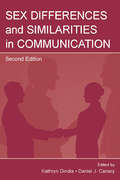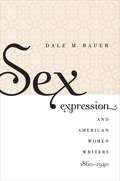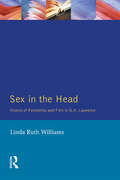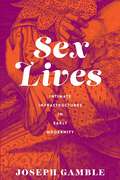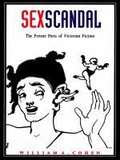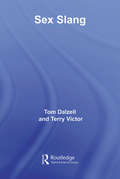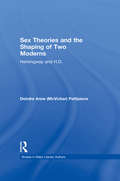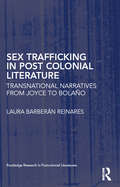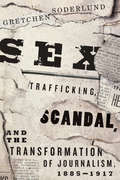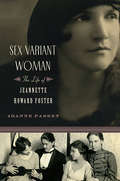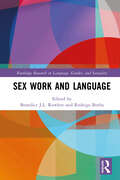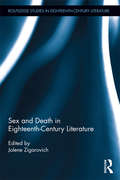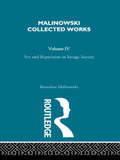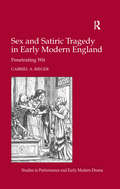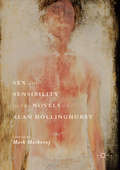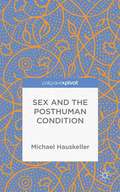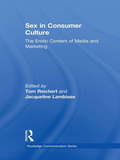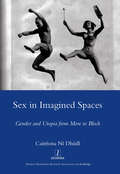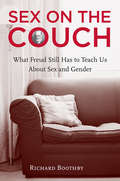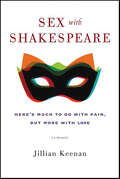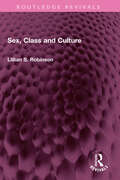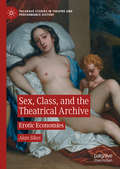- Table View
- List View
Sex Differences and Similarities in Communication (Routledge Communication Series)
by Daniel J. Canary Kathryn DindiaSex Differences and Similarities in Communication offers a thorough exploration of sex differences in how men and women communicate, set within the context of sex similarities, offering a balanced examination of the topic. The contents of this distinctive volume frame the conversation regarding the extent to which sex differences are found in social behavior, and emphasize different theoretical perspectives on the topic. Chapter contributors examine how sex differences and similarities can be seen in various verbal and nonverbal communicative behaviors across contexts, and focus on communication behavior in romantic relationships. The work included here represents recent research on the topic across various disciplines, including communication, social psychology, sociology, linguistics, and organizational behavior, by scholars well-known for their work in this area. In this second edition, some chapters present new perspectives on sex/gender and communication; others present substantially revised versions of earlier chapters. All chapters have a stronger theoretical orientation and are based on a wider range of empirical data than those in the first edition. Readers in communication, social psychology, relationships, and related fields will find much of interest in this second edition. The volume will serve as a text for students in advanced coursework as well as a reference for practitioners interested in research-based conclusions regarding sex differences in communicative behavior.
Sex Expression and American Women Writers, 1860-1940
by Dale M. BauerAmerican women novelists of the late nineteenth and early twentieth centuries registered a call for a new sexual freedom, Dale Bauer contends. By creating a lexicon of "sex expression," many authors explored sexuality as part of a discourse about women's needs rather than confining it to the realm of sentiments, where it had been relegated (if broached at all) by earlier writers. This new rhetoric of sexuality enabled critical conversations about who had sex, when in life they had it, and how it signified.Whether liberating or repressive, sexuality became a potential force for female agency in these women's novels, Bauer explains, insofar as these novelists seized the power of rhetoric to establish their intellectual authority. Thus, Bauer argues, they helped transform the traditional ideal of sexual purity into a new goal of sexual pleasure, defining in their fiction what intimacy between equals might become.Analyzing the work of canonical as well as popular writers--including Edith Wharton, Anzia Yezierska, Julia Peterkin, and Fannie Hurst, among others--Bauer demonstrates that the new sexualization of American culture was both material and rhetorical.
Sex In The Head: Visions of Femininity and Film in D.H. Lawrence
by Linda R. WilliamsIn Sex in the Head, Linda Ruth Williams uses psychoanalysis and recent feminist film theory to analyze a network of ideas which link looking with sexuality and difference, in the work of a writer who disavowed, yet covertly enjoyed, the pleasures and power of vision. The book is a departure from the long history of feminist readings of Lawrence, in that it discusses his engagement with theories of the gaze and its cultural forms - cinema, photography, painting and the visual dynamics and metaphors of literary texts - as a way of thinking through gender. It shows him arguing, on the one hand, against the evils of cinema and visual sex, while relishing, through the eyes of women, the moving spectacle of those male bodies which populate the pages of his books. It also questions what it is about the work of such an adamant cinephobe which has made it so thoroughly adaptable for film and television.
Sex Lives: Intimate Infrastructures in Early Modernity
by Joseph GambleIn Sex Lives, Joseph Gamble draws from literature, art, and personal testimonies from sixteenth- and seventeenth-century Europe to uncover how early moderns learned to have sex. In the early modern period, Gamble contends, everyone from pornographers to Shakespeare recognized that sex requires knowledge of both logistics (how to do it) and affect (how to feel about it). And knowledge, of course, takes practice.Gamble turns to a wide range of early modern texts and images from England, France, and Italy, ranging from personal accounts to closet dramas to visual art in order to excavate and analyze a variety of sexual practices in early modernity. Using an intersectional, phenomenological approach to bring historical light to the quotidian sexual experiences of early modern subjects, the book develops the critical concept of the “sex life”—a colloquialism that opens up methodological avenues for understanding daily lived experience in granular detail, both in the distant past and today. Through this lens, Gamble explores how sex organized and permeated everyday life and experiences of gender and race in early modernity. He shows how affects around sex structure the plays of Shakespeare and his contemporaries, revealing the role of sexual feeling and sexual racism in early modern English drama.Sex Lives reshapes how we understand Renaissance literature, the history of sexuality, and the meaning of sex in both early modern Europe and our own moment.
Sex Scandal: The Private Parts of Victorian Fiction
by William A. CohenNever has the Victorian novel appeared so perverse as it does in these pages--and never his its perversity seemed so fundamental to its accomplishment. Whether discussing George Eliot's lesbian readers, Anthony Trollope's whorish heroines, or Charles Dickens's masturbating characters, William A. Cohen's study explodes the decorum of mainstream nineteenth-century fiction. By viewing this fiction alongside the most alarming public scandals of the day, Cohen exposes both the scandalousness of this literature and its sexiness.Scandal, then as now, makes public the secret indiscretions of prominent people, engrossing its audience in salacious details that violate the very code of propriety it aims to enforce. In narratives ranging from Great Expectations to the Boulton and Park sodomy scandal of 1870-71, from Eliot's and Trollope's novels about scandalous women to Oscar Wilde's writing and his trials for homosexuality, Cohen shows how, in each instance, sexuality appears couched in coded terms. He identifies an assortment of cunning narrative techniques used to insinuate sex into Victorian writing, demonstrating that even as such narratives air the scandalous subject, they emphasize its unspeakable nature.Written with an eye toward the sex scandals that still whet the appetites of consumers of news and novels, this work is suggestive about our own modes of imagining sexuality today and how we arrived at them. Sex Scandal will appeal to scholars and general readers interested in Victorian literature, the history of sexuality, gender studies, nineteenth-century Britain, and gay, lesbian, and queer studies.
Sex Slang
by Tom Dalzell Terry VictorAre you a beaver cleaver or the office bike? Would you rather pack fudge or munch carpet? Do you content yourself with paddling the pickle as you’re still a cherry boy? Sex Slang will not only give you 3,000 words to talk about your favourite pastimes, but also open your eyes to practices you didn’t even know existed. All words are illustrated by a reference from a variety of sources to prove their existence. This naughty book will give you a spectacular sexual vocabulary from all over the English speaking world, as well as hours of reading pleasure.
Sex Theories and the Shaping of Two Moderns: Hemingway and H.D. (Studies in Major Literary Authors #11)
by Deirdre Anne PettipieceThis book examines the impact of scientific and sexologic theories on the creation of character in the prose of two moderns, Hemingway and H.D.
Sex Trafficking in Postcolonial Literature: Transnational Narratives from Joyce to Bolaño (Routledge Research in Postcolonial Literatures)
by Laura Barberán ReinaresAt present, the bulk of the existing research on sex trafficking originates in the social sciences. Sex Trafficking in Postcolonial Literature adds an original perspective on this issue by examining representations of sex trafficking in postcolonial literature. This book is a sustained interdisciplinary study bridging postcolonial literature, in English and Spanish, and sex trafficking, as analyzed through literary theory, anthropology, sociology, history, trauma theory, journalism, and globalization studies. It encompasses postcolonial theory and literature’s aesthetic analysis of sex trafficking together with research from social sciences, psychology, anthropology, and economics with the intention of offering a comprehensive analysis of the topic beyond the type of Orientalist discourse so prevalent in the media. This is an important and innovative resource for scholars in literature, postcolonial studies, gender studies, human rights and global justice.
Sex Trafficking, Scandal, and the Transformation of Journalism, 1885-1917
by Gretchen SoderlundDuring the first half of the nineteenth century, the penny presses of the industrial East treated brothels as a mundane, if annoying, aspect of city life. But later in the century, reformers and mainstream papers began to push back against this representation through highly public campaigns against "white slavery. " These newspaper crusades mixed a potent cocktail of lurid sexual detail and sensationalist scandal aimed equally at promoting anti-vice measures, arousing popular demand for progressive reform, and increasing newspaper circulation. In Sex Trafficking, Scandal, and the Transformation of Journalism, Gretchen Soderlund offers a new way to understand sensationalism in both newspapers and reform movements. By tracing the history of high-profile print exposés on sex trafficking by journalists like William T. Stead and George Kibbe Turner, Soderlund demonstrates how controversies over gender, race, and sexuality were central to the shift from sensationalism to objectivity--and crucial to the development of journalism in the early twentieth century.
Sex Variant Woman: The Life of Jeanette Howard Foster
by Joanne PassetA stunning biography of the long-neglected, firebrand author of the obible of lesbian literature, OCO Jeannette Howard Foster"
Sex Work and Language (Routledge Research in Language, Gender, and Sexuality)
by Rowlett, Benedict J.L. Rodrigo BorbaThis collection brings together established and exciting new voices to shed light on the language of and about sex work, offering an empirically nuanced understanding of commercial sex through language.While there is burgeoning literature on sex work in the social sciences, there has been little work to date centering it from a linguistic perspective. Chapters make the case for language as central to sex work practices and the transactions of intimacy in the negotiation of services, promotional strategies and the performance of desire. Featuring insights from diverse geographic contexts, the chapters critically reflect on different dimensions of language and sex work, including sex work, gender and desire; online sex work; sex work and race; sex worker advocacy; and the language of victimization and exploitation. The volume illuminates the ways in which commercial sex work is negotiated in embodied linguistic interaction and attendant issues of power, identity, gender, race and desire.This book systematizes the body of growing knowledge around language and sex work from an interdisciplinary lens. It is key reading for scholars, policymakers and activists in sociolinguistics and discourse analysis, as well as fields such as anthropology, sociology, criminology and health and social care.
Sex and Aesthetics in Samuel Becketts Work (New Interpretations of Beckett in the Twenty-first Century)
by Paul StewartThis book places sex and sexuality firmly at the heart of Beckett. From the earliest prose to the late plays, Paul Stewart uncovers a profound mistrust of procreation which nevertheless allows for a surprising variety of non-reproductive forms of sex which challenge established notions of sexual propriety and identity politics.
Sex and Death in Eighteenth-Century Literature (Routledge Studies in Eighteenth-Century Literature #10)
by Jolene ZigarovichThis book discusses sex and death in the eighteenth-century, an era that among other forms produced the Gothic novel, commencing the prolific examination of the century’s shifting attitudes toward death and uncovering literary moments in which sexuality and death often conjoined. By bringing together various viewpoints and historical relations, the volume contributes to an emerging field of study and provides new perspectives on the ways in which the century approached an increasingly modern sense of sexuality and mortality. It not only provides part of the needed discussion of the relationship between sex, death, history, and eighteenth-century culture, but is a forum in which the ideas of several well-respected critics converge, producing a breadth of knowledge and a diversity of perspectives and methodologies previously unseen. As the contributors demonstrate, eighteenth-century anxieties over mortality, the body, the soul, and the corpse inspired many writers of the time to both implicitly and explicitly embed mortality and sexuality within their works. By depicting the necrophilic tendencies of libertines and rapacious villains, the fetishizing of death and mourning by virtuous heroines, or the fantasy of preserving the body, these authors demonstrate not only the tragic results of sexual play, but the persistent fantasy of necro-erotica. This book shows that within the eighteenth-century culture of profound modern change, underworkings of death and mourning are often eroticized; that sex is often equated with death (as punishment, or loss of the self); and that the sex-death dialectic lies at the discursive center of normative conceptions of gender, desire, and social power.
Sex and Repression in Savage Society: [1927] (Routledge Classics Ser.)
by Bronislaw MalinowskiThis volume explores and challenges the applicatio psychoanalytic theory to the study of traditional societies.
Sex and Satiric Tragedy in Early Modern England: Penetrating Wit (Studies in Performance and Early Modern Drama)
by Gabriel A. RiegerDrawing upon recent scholarship in Renaissance studies regarding notions of the body, political, physical and social, this study examines how the satiric tragedians of the English Renaissance employ the languages of sex - including sexual slander, titillation, insinuation and obscenity - in the service of satiric aggression. There is a close association between the genre of satire and sexually descriptive language in the period, author Gabriel Rieger argues, particularly in the ways in which both the genre and the languages embody systems of oppositions. In exploring the various purposes which sexually descriptive language serves for the satiric tragedian, Rieger reviews a broad range of texts, ancient, Renaissance, and contemporary, by satiric tragedians, moralists, medical writers and critics, paying particular attention to the works of William Shakespeare, Thomas Middleton and John Webster
Sex and Sensibility in the Novels of Alan Hollinghurst
by Mark MathurayThis book is a challenging and engaging collection of original essays on the novels of Alan Hollinghurst, Britain's foremost gay writer and the English novel's master stylist. The essays engage the precarious and shifting relationship between sex and literary sensibility in his novels and, thus, also attempt to establish the parameters of a new critical discourse for future research on Hollinghurst's novel, queer theory and the contemporary literary representations of masculinity and sexuality. By coupling the consideration of Hollinghurst's aesthetics, his sensuously evocative style, to an interrogation of the social, political and sexual currents in his texts, the contributors of this collection provide distinctive interpretations of Hollinghurst's novels, from Hollinghurst's uncovering of a gay artistic heritage to his re-signification of earlier English literary styles, from his engagement with the Symbolist fin de si#65533;cle to his critique of aestheticism, etc. , whilst paying close attention to the formally innovative qualities of his texts.
Sex and the Posthuman Condition
by Michael HauskellerThis book looks at how sexuality is framed in enhancement scenarios and how descriptions of the resulting posthuman future are informed by mythological, historical and literary paradigms. It examines the glorious sex life we will allegedly enjoy due to greater control of our emotions, improved capacity for pleasure, and availability of sex robots.
Sex in Consumer Culture: The Erotic Content of Media and Marketing (Routledge Communication Series)
by Tom Reichert Jacqueline LambiaseSex in Consumer Culture: The Erotic Content of Media and Marketing considers the use of sex to promote brands, magazines, video games, TV programming, music, and movies. Offering both quantitative and qualitative perspectives from leading scholars in a variety of disciplines, this volume addresses a range of integral issues such as media promotion, racial representations, appeals to gay and lesbian communities, content analyses, and case studies. Chapters represent diverse perspectives, addressing such questions as:*What happens when sexual content created for adults reaches children?*What meaning do sexual words and images have within the contexts of sporting events, trade shows, video games, personal ads, or consumer Web sites?*What effects might sex-tinged images have on audiences, and where should the focus be for new effects research?*Where are the current boundaries between pornography and mainstream sexual depictions?Exploring sexual information as it is used in mass media to sell products and programs, Sex in Consumer Culture is an important collection, and it will be of great interest for scholars and students in advertising, marketing, media promotion, persuasion, mass communication & society, and gender studies.
Sex in Imagined Spaces: Gender and Utopia from More to Bloch
by Caitriona DhuillFrom Thomas More onwards, writers of utopias have constructed alternative models of society as a way of commenting critically on existing social orders. In the utopian alternative, the sex-gender system of the contemporary society may be either reproduced or radically re-organised. Reading utopian writing as a dialogue between reality and possibility, this study examines the relationship between historical sex-gender systems and those envisioned by utopian texts. Surveying a broad range of utopian writing from the nineteenth and twentieth centuries, including Huxley, Zamyatin, Wedekind, Hauptmann, and Charlotte Perkins Gilman, this book reveals the variety and complexity of approaches to re-arranging gender, and locates these 're-arrangements' within contemporary debates on sex and reproduction, masculinity and femininity, desire, taboo and family structure. These issues occupy a position of central importance in the dialogue between utopian imagination and anti-utopian thought which culminates in the great dystopias of the twentieth century and the postmodern re-invention of utopia.
Sex on the Couch: What Freud Still Has To Teach Us About Sex and Gender
by Richard BoothbyFirst published in 2006. Routledge is an imprint of Taylor & Francis, an informa company.
Sex with Shakespeare: Here's Much to Do with Pain, but More with Love
by Jillian KeenanA provocative, moving, kinky, and often absurdly funny memoir about Shakespeare, love, obsession, and spankingWhen it came to understanding love, a teenage Jillian Keenan had nothing to guide her—until a production of The Tempest sent Shakespeare’s language flowing through her blood for the first time. In Sex with Shakespeare, she tells the story of how the Bard’s plays helped her embrace her unusual sexual identity and find a love story of her own.Four hundred years after Shakespeare’s death, Keenan’s smart and passionate memoir brings new life to his work. With fourteen of his plays as a springboard, she explores the many facets of love and sexuality—from desire and communication to fetish and fantasy. In A Midsummer Night’s Dream, Keenan unmasks Helena as a sexual masochist—like Jillian herself. In Macbeth, she examines criminalized sexual identities and the dark side of “privacy.” The Taming of the Shrew goes inside the secret world of bondage, domination, and sadomasochism, while King Lear exposes the ill-fated king as a possible sexual predator. Moving through the canon, Keenan makes it abundantly clear that literature is a conversation. In Sex with Shakespeare, words are love.As Keenan wanders the world in search of connection, from desert dictatorships to urban islands to disputed territories, Shakespeare goes with her —and provokes complex, surprising, and wildly important conversations about sexuality, consent, and the secrets that simmer beneath our surfaces.
Sex, Class and Culture (Routledge Revivals)
by Lillian RobinsonFirst published in 1986, Sex, Class and Culture is a collection of Marxist feminist essays that develops an original critical theory and applies it to literature, the visual arts, and mass media. Lillian Robinson was the first American critic to suggest the essential connections among sex, class, and race as forces that shape works of art and the critical response to them. In applying her theory to particular texts, she considers topics from the Renaissance epic to the Regency romance, from Jane Austen to contemporary feminist poets, and from factory workers’ memoirs to TV images of career women and housewives. The essays are insightful because Robinson clearly knows this wide assortment of texts, cares about their significance, and writes about them with wit. They are irreverent, because she asserts the feminist critic’s permanent responsibility to ask "So What?" and they are controversial because she constantly addresses that question to our most powerful and respectable institutions – social and literary. This book will be of interest to students of literature, history, gender studies and sexuality studies.
Sex, Class, and the Theatrical Archive: Erotic Economies (Palgrave Studies in Theatre and Performance History)
by Alan SikesIn Sex, Class and the Theatrical Archive: Erotic Economies, Alan Sikes explores the intersection of struggles over sex and class identities in politicized performances during key revolutionary moments in modern European history. The book includes discussions of sodomitical closet dramas from the decades surrounding the English Glorious Revolution of 1688; the performances of 'Tribades and Amazons', public women of the French Revolution; the 'homophilic elitism' in the early plays of Brecht and Hasenclever from the years just before and after the German Revolution that marked the founding of the short-lived Weimar Republic; and the utopian conception of a Soviet 'New Woman' set to take the stage after the Russian Revolution of 1917. Throughout, Sikes invokes the differences between past and present politicized performances in order to cast our own political imaginings into sharper and more critical relief.
Sex, Drugs, and Fashion in 1970s Madrid (Toronto Iberic)
by Francisco Fernandez de AlbaDuring the last decade of Franco’s repressive rule, the Spanish outlook on sex, drugs, and fashion shifted dramatically, creating a favorable cultural environment for the return of democracy. Exploring changes in urban planning, narratives of sexual and gender identity, recreational drug use, and fashion design during the seventies, Sex, Drugs, and Fashion in 1970s Madrid argues that it was during this decade that the material and emotional conditions for the groundbreaking transition to democracy first began to develop. Thanks in part to a mass media saturated with international trends, citizens of Madrid began to adopt practices, behaviors, and attitudes that would ultimately render Franco’s military dictatorship obsolete. This cultural history examines these modest but irreversible changes in the way people lived and thought about their lives during the last decade of the regime’s creed. Not a revolution necessarily, but transformational nevertheless, these changes in collective sensibility eased the political transition to democracy and the emergence of the eighties’ cultural movement la Movida.
Sex, Gender and Time in Fiction and Culture
by Ben Davies Jana FunkeInvestigating modern art, literature, theory and the law, this book illustrates the different ways in which sex, gender and time intersect. It demonstrates that time offers new critical perspectives on sex and gender and makes problematic reductive understandings of sexual identity as well as straight and queer time
